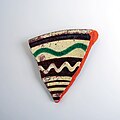Lower Rhine farmer's pottery
The Lower Rhine farmer's pottery is a type of ceramic ware from the 17th to 19th centuries and plays a major role in historical research on the Lower Rhine . The ceramic products, often referred to as Lower Rhine earthenware , are characterized by the pictorial representation of religious motifs and everyday scenes from the early modern period . They usually have a red body and are painted with a slip paint in the colors brown, yellow and green.
Holiday bowls
Particularly prominent representatives of the Lower Rhine farmer's pottery are the so-called festival bowls. These bowls or bowls with a diameter of up to 80 cm were mostly personal one-offs for a specific occasion. Such bowls were popular e.g. B. as a wedding gift. These were less suitable for use. Rather, the holiday bowls were hung on the wall as decoration or placed on shelves or on mantels.
In addition to religious motifs, the motif inventory of the holiday bowls often also includes depictions of courtship and weddings.
Production centers
The core area of earthenware production in the Lower Rhine region, the so-called pot bakers , was the area between Krefeld and Kleve in the 17th to 19th centuries . In 1923 the artist Heinrich Dieckmann and Heribert Reiners started an attempt to revive the Lower Rhine farmer's pottery with sacred motifs in a workshop in Frechen . The specially founded company "Niederrheinische Werkstatt für Pöpferei" was closed again in the same year.
Picture gallery
Bowl. 17th century. Kalkar Municipal Museum , Kalkar .
Wall tiles, Burg Linn Museum .
literature
- Working group Niederrheinische Earthenware (ed.): Thrown away from the earth on the table and found again - 300 years of earthenware from the Lower Rhine. Krefeld-Linn 2009.
- Wolfgang Hackspiel (Ed.): "The broken glass complex from Haus Gelinde". Rheinland Verlag, 1993.
- Alexandra Mars: Ceramics from Gennep. Archaeological study of an 18th century pottery workshop. Guidebooks and publications of the Rhenish Open Air Museum and State Museum for Folklore in Kommern, No. 45. Janssen Pers, Gennep 1991.
- Joachim Naumann (Ed.): Ceramics from the Lower Rhine. Cologne 1988. ISBN 3-927396-00-1
- Christoph Reichmann: Holiday bowls from the Lower Rhine. Museum Burg Linn, Krefeld 1989.
- Mechthild Scholten-Neess; Werner Jüttner: Lower Rhine farmer's pottery 17th - 19th century. Düsseldorf 1977. ISBN 3-7927-0070-0
- Guido Tersteegen (ed.): "Products of a pottery workshop in the Lower Rhine region from 1691-1802". Issum 2011, ISBN 978-3-00-034376-6
- Lutz Weynans: "Finds of stove and utility ceramics from the 18th and 19th centuries in the Tönisberg area". Tönisberger Heimatblätter 2007.
- Lutz Weynans: "The latest findings and evidence of the Tönisberg pottery history". Tönisberger Heimatblätter 2010
- Lutz Weynans: "Evaluation of a find-recovery Tönisberg pottery waste". Tönisberger Heimatblätter 2011.
- Lutz Weynans: "Failed and disposed of - failed fires from Tönisberg workshops". Tönisberger Heimatblätter 2012.
- Lutz Weynans: "A complex of finds of decorated earthenware from the 16th century from Venlo", Hallesche Contributions to the Archeology of the Middle Ages, 2016
Web links
- Website of the "Lower Rhine Earthenware Working Group"
- Regional Association of Rhineland "Potters on the left Lower Rhine (17th-19th centuries)"
Remarks
- ↑ Maria Kevelaer bowl (78cm diameter), Sonsbeck 1720, Kunstmuseen Krefeld , Inv. No. 1905/56.
- ↑ Wolfgang Hackspiel: The manufacture of the Lower Rhine earthenware . In: Joachim Naumann (ed.): Ceramic from the Lower Rhine. Cologne 1988. p. 255.
- ^ Monika Joggerst: Heinrich Dieckmann. Life and work 1890-1963. Diss. Bochum 2002, p. 77ff.



